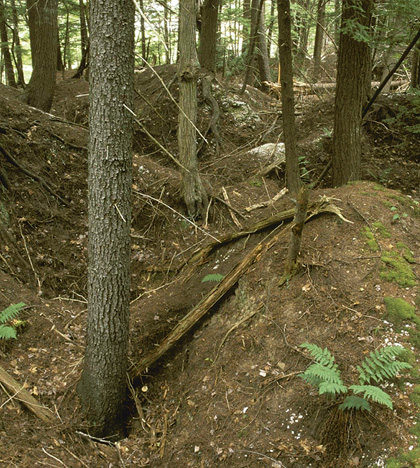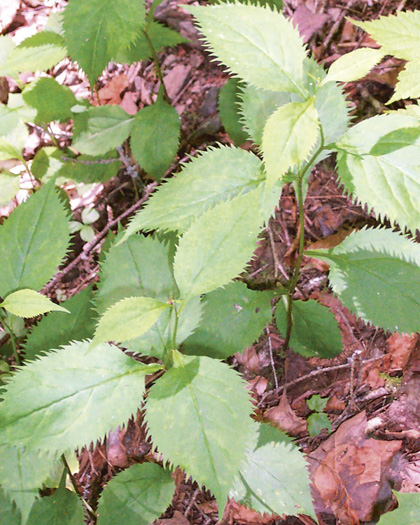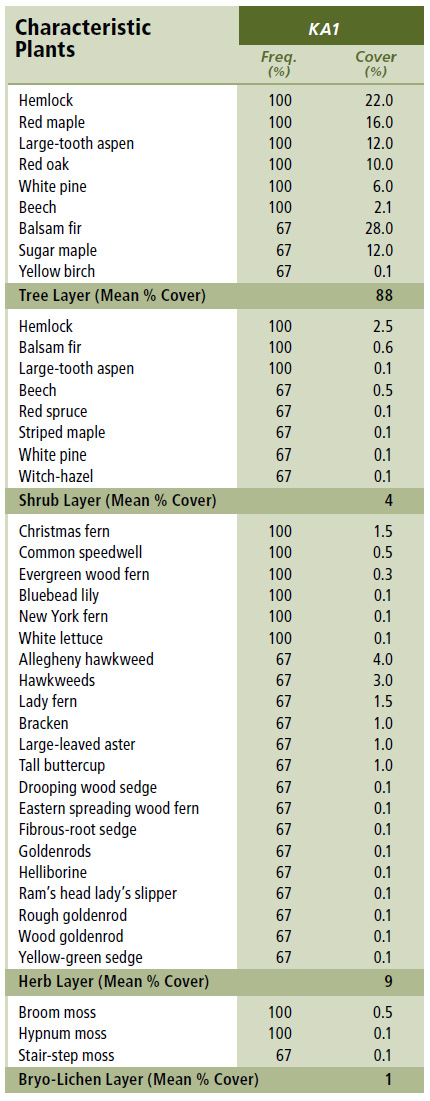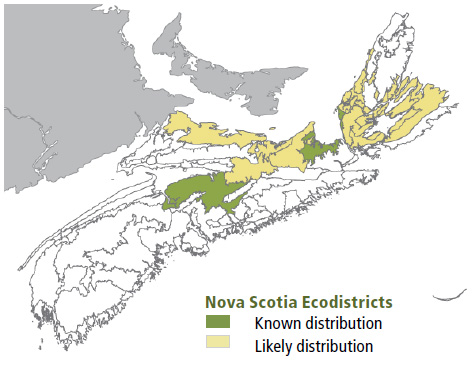
Forest Vegetation types - KA1
KA1 — Hemlock / Christmas fern – White lettuce – Wood goldenrod
Tsuga canadensis/ Polystichum acrostichoides – Prenanthes altissima – Solidago flexicaulis
 |
Brooklyn, Hants County |
Concept: The late successional Hemlock / Christmas fern – White lettuce – Wood goldenrod forest is characterized by its canopy composition and unique karst site conditions. The overstory is dominated by hemlock and a variety of hardwoods including red maple, large-tooth aspen and red oak. Similar to other forests dominated by hemlock—our longest living and most shade-tolerant conifer—this Vegetation Type (VT) will develop old forest characteristics, maintained by gap disturbances.
Vegetation: The canopy is characterized by intermediate to high levels of hemlock. Red maple, large-tooth aspen
and red oak are common deciduous components of stand structure, while white pine and balsam fir may be important co-dominants in some stands. Understory layers are usually sparse and species-poor, although several species show high frequency (e.g. striped maple, white lettuce, Christmas fern, wood goldenrod, drooping wood sedge, among others). Bryophyte cover is reduced. Plant species locally associated with karst are not frequent in plot data because many of these species are sparsely scattered across karst talus slopes. On deeper soils, where alkaline bedrock is further from the rooting zone, nutrient enrichment is weakened, further limiting the prominence of karst plants. The KA1 ecosystem has fewer karst plants than KA2 (a deciduous karst forest) because in KA1 the forest floor is heavily shaded.
Environmental Setting: KA1 occurs on fresh to moist and nutrient medium to rich soils. This ecosystem is only found on karst topography, a rugged landform with scattered bedrock exposures and steep sided sinkholes. This VT is mainly found in the Central Lowlands and Bras d'Or Lowlands ecodistricts. Microtopography is usually weakly expressed due to the shallow surficial deposits which limit rooting potential. This VT occurs in southern New Brunswick but is very uncommon. It is absent from Prince Edward Island.
Successional Dynamics: Depending on disturbance history, this late successional VT can be even-aged, but will develop an uneven-aged structure as it matures. Disturbance agents include wind, insects/disease, harvesting and karst forming processes (e.g. bedrock dissolution, soil subsidence and sinkhole formation). These processes can open relatively large canopy gaps and expose mineral soil, promoting shade-intolerant hardwoods.
Ecological Features: This VT occurs as a small to large patch in areas where glacial tills are underlain by calcareous bedrock. This uncommon closed canopy community supports many rare plants, including yellow and ram's head lady's slippers and leatherwood. Ram's head lady's slipper is legally protected and listed as endangered under the Nova Scotia Endangered Species Act. Most karst in Nova Scotia develops over gypsum deposits forming rugged landforms with funnel shaped sinkholes, subterranean caves and tunnels. Caves may be used by porcupine, creating unique cave faunal communities associated with porcupine dung. Larger caves, some up to several hundred meters deep, may also provide important winter hibernacula for bats. Karst landscapes contain a diverse mix of habitats ranging from dry hill crests and actively collapsing sinkholes to small alkaline ponds and wetlands. Their calcareous soils support the greatest diversity of land snails in the Province. Gypsum and limestone quarrying, which are common in areas of Nova Scotia karst, has detrimental impacts on biodiversity.
 |
| Wood goldenrod |
Distinguishing Features: This is a broadly defined softwood forest occurring on karst topography. Hemlock is usually the dominant overstory species, but depending on past disturbances and successional stage other species such as balsam fir, red spruce, white spruce, red maple, aspen, birch and red oak may be present.
| Slope Position: | Level3 Lower3 Middle3 |
Surface Stoniness: |
(Non - Slightly)10 |
Bedrock Outcrop: |
(Non-rocky)7 (Slightly - Moderately)3 |
Elevation Range: |
13 - 41m |
Slope Gradient: |
Gentle3 Level3 Steep3 |
Aspect: |
North3 South3 None3 |
Exposure: |
Moderate3 Mod. Exposed3 Sheltered3 |
Microtopography: |
Level7 Strongly3 |
Drainage: |
Well10 |
Soil Type: |
ST2-L3 ST83 nd3 |
Parent Material: |
Glacial till10 |
Rooting Depth (cm): |
(>45)7 nd3 |
Duff Thickness (cm): |
(0-5)7 nd3 |

